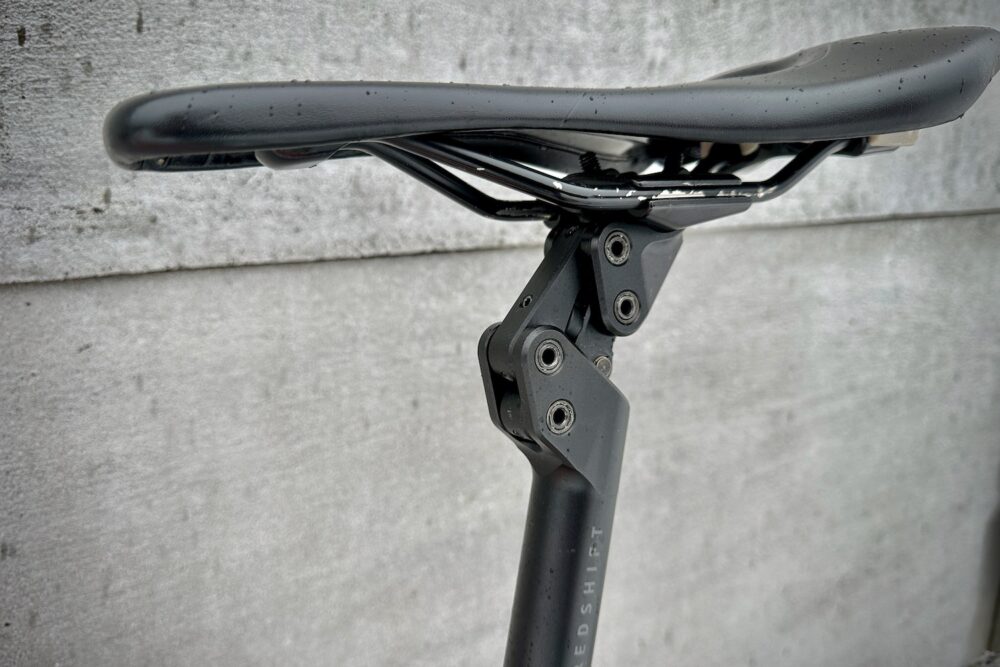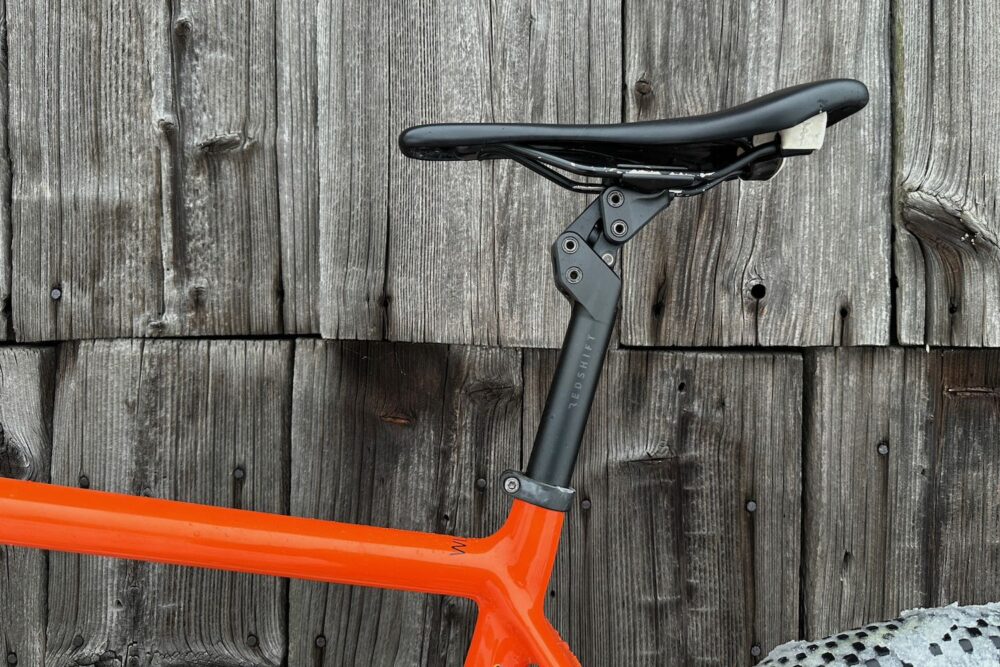Table of Contents
Gravel bikes are optimised to be fast and efficient on various road surfaces. They roll along on narrow tires, are built lightweight, and usually forgo a suspension fork and rear shock.
As a result, they transmit more shock and vibration to a rider than a typical mountain bike, resulting in more fatigue and discomfort.
This doesn’t have to be the case, however.

Innovative companies like Redshift offer suspension stems and seatposts that can be fitted to any bike and can isolate a rider from bumps, potholes, and rough surfaces.
I’ve been using the Redshift ShockStop Standard suspension seatpost for three years now. It looks neat, it has been reliable, and most importantly, it has suited my needs well. My previous vibration tests have shown that the ShockStop Standard provides a significant comfort improvement.
The Redshift ShockStop Pro V2 is the latest suspension seatpost on the market. While most suspension seatposts make use of coil springs or elastomer springs, the Pro utilises both spring types.
So, how does this combination of springs perform in my vibration tests? Let’s find out.
What is the Redshift ShockStop Pro Seatpost?
The ShockStop Pro is ideal for riders looking for a seatpost that’s both incredibly comfortable and largely unobtrusive.
US $299 (RRP)
REASONS TO BUY
1. Highly effective at reducing shock
2. It’s not too bouncy
3. It’s lightweight
REASONS NOT TO BUY
1. It’s expensive
2. The suspension travel is only 20mm
3. It’s not very adjustable
The ShockStop Pro seatpost is the newest addition to the Redshift’s extensive component range. It’s marketed to those who ride and race gravel bikes and people who might be concerned with the additional weight a suspension seatpost brings.
Weighing in at as little as 380 grams, the ShockStop Pro is just 150 grams heavier than a typical aluminium seatpost. But for this extra weight, you gain 20mm of buttery suspension travel.
The ShockStop Pro is expensive at US $299 but it’s not unreasonably priced given the quality of materials used, and the additional comfort it offers (we’ll get to my vibration test results soon).

This suspension seatpost is available in two lengths (280 or 350 mm) and one diameter (27.2mm). If you use a larger diameter seat tube (eg. 31.8mm) you can easily buy the appropriate shim for a perfect fit.
You can use the ShockStop Pro with round 7mm or oval 7×9 mm rails, and the seatpost is suitable for those <50kg/110lb right through to 110kg/242lb.
Redshift is so confident that you’ll like their seatposts that they come with a 90-day guarantee. This allows for a 100% risk-free trial, and if you don’t like it, you can get a full product refund, no questions asked. There’s a lifetime warranty on the seatpost too.
How is the new ShockStop Pro different from the ShockStop Standard?
How Does The Pro Compare To The Standard?

Spring Type
The ShockStop Standard is suspended using only metal coil springs, which results in an ultra-responsive seatpost with excellent bump-eating comfort. According to my vibration tests, fast-moving coil springs tend to yield the most comfort over the small, high-frequency bumps found on gravel roads.
You can modify the spring stiffness by using either one or two coil springs – the spring rate is selected based on your body weight, riding style, and terrain.
The main downside to seatposts that use coil springs (without any source of damping) is that they can bounce up and down a bit as you pedal.

The ShockStop Pro, on the other hand, combines one (or two) coil springs with an elastomer spring that all nest together. The coil springs allow the seatpost to be responsive to bumps, while the elastomer spring calms the suspension movement with its additional material damping.
As a result, the ShockStop Pro seatpost not only has a great feel but it’s both less bouncy and less intrusive while you ride.
If you like, you can also remove the coil spring and install two elastomers instead. This reduces the bounciness almost entirely, however, it’s at the cost of the seatpost’s responsiveness to bumps. This could be the optimal solution for those who primarily ride on smooth roads.
Suspension Travel

The ShockStop Standard employs 35mm of suspension travel, which provides excellent comfort on notably rough terrain – think singletrack, 4×4 trails, and bumpy dirt roads.
The ShockStop Pro uses just 20mm of suspension travel. This essentially means it cannot absorb bumps as large, making it better suited to smooth-to-moderate gravel roads.
Product Weight
The ShockStop Standard seatpost is between 127 and 287 grams heavier than the ShockStop Pro. The weight difference between models depends on the seatpost lengths, diameters, and spring configurations.
Adjustability

The beauty of the ShockStop Standard is that you can fine-tune the suspension movement.
After you’ve fitted the appropriate coil spring(s), it’s time to adjust the pre-load. This plug adjusts both the spring stiffness and the initial firmness of the seatpost – it’s quite an effective way to fine-tune the seatpost to your desired feel.
In comparison, the ShockStop Pro has no way to fine-tune the initial firmness, you can only use different combinations of springs. This could result in some riders being unable to find the perfect spring stiffness for their needs.
Finish, Materials, and Sizes
The ShockStop Pro has blacked-out graphics, making it look more pro. It’s made from the same 6061 T6 aluminium as the Standard, however, it additionally features hollowed-out pivot pins, and more aggressively machined linkage arms to shed some grams off.
The ShockStop Standard seatpost can be purchased in 27.2, 30.4, 30.9, and 31.6mm diameters, and the largest diameter seatposts are available in lengths up to 450mm.
In comparison, the StockStop Pro is 27.2mm only in 280 or 350mm lengths (you will need to use shims for larger diameter seat tubes).
How Do You Set Up The Spring Rate?

To set up the seatpost, you will need to play around with the two elastomer springs and two coil springs (inner and outer) that it comes with.
I started off riding the seatpost with the recommended stiff elastomer (red) and both coil springs (87kg/192lb weight). But this was too firm. I next tried the soft elastomer (green) and both coil springs. The result this time was a seatpost that was too soft and bouncy.
The final step was re-installing the stiff elastomer (red) but removing the inner coil spring. This now felt subjectively on par with my ShockStop Standard seatpost.
How Does the Redshift ShockStop Pro Ride?

The first thing you will notice with either Redshift suspension seatpost is that you can forget your old way of riding; you no longer need to ‘unweight’ your saddle when you ride over bumps – you can just pedal straight over them.
Of course, the bigger bumps required me to unweight my saddle a bit more than usual due to the ShockStop Pro’s reduced suspension travel.
I’ve noticed that after a big hit, the ShockStop Pro firms up quickly, especially when you’re deeper in the travel. In comparison, the ShockStop Standard feels more plush. This is likely a result of the reduction in suspension travel (20mm vs. 35mm) but could be due to the properties of the elastomer spring too.
The overall feel of the seatpost with an elastomer spring is an improvement over the ShockStop Standard; the Pro has a more refined movement. But it’s not night and day, both seatposts feel very responsive to inputs from the ground.
Let’s now see how both seatposts performed in my vibration tests.
My Test Bike and Vibration Measurement Procedure

I conducted this Redshift seatpost comparison using my Open WI.DE gravel bike fitted with Rene Herse Umtanum Ridge 650B x 55 mm tires at 35 psi (2.5 bar).
You can read more about my benchmark bike HERE.
I have two test scenarios: a big hit test that simulates riding across a 30mm tall obstacle like a tree root or edgy rock, and a high-frequency chatter test that simulates riding on a bumpy gravel road.
You can read more about my vibration measurement procedure HERE.
Vibration Test Results
Big Hit Test

In the big hit test, the ShockStop Pro seatpost performed significantly better than the Standard, showing almost 60% less vibration at the saddle (on average).
The Pro seatpost was destined to do well in this test as the coil spring could respond quickly to the impact, and the elastomer spring could remove the unwanted oscillations after the big hit.
While the numbers suggest a huge win for the Pro seatpost, I didn’t perceive a big difference in ride comfort. The most noticeable difference ‘at the butt’ was the reduced bounciness.
High-Frequency Chatter Test

The ShockStop Pro seatpost performed better in the high-frequency chatter test too, however, this time there was 14% less vibration compared to the ShockStop Standard (on average).
Again, the elastomer spring’s material damping proved advantageous over fast, repetitive bumps – it was able to reduce the overall vibration at the saddle, although at a reduced rate.
Ultimately, both Redshift seatposts do very well in this test thanks to their ultra-responsive coil springs. The most noticeable difference is that the Pro feels more refined in its movement, however, this is only a minor comfort difference.
Summary

There is no doubt that the Redshift ShockStop Pro seatpost takes ride comfort up a notch with its clever use of coil and elastomer springs. It’s the most comfortable seatpost I’ve ever tested with my vibration-measuring equipment.
The coil spring responds quickly to bumps, and the elastomer spring keeps the ‘bounciness’ in check by removing unwanted vibrations from the system. And with a weight between 380 to 445 grams, it won’t add any considerable weight to your bike.
The ShockStop Pro is ideal for more performance-oriented riders looking for a seatpost that’s comfortable and unobtrusive. The 20mm of suspension travel is perfect for most gravel surfaces, and it performs well on smoother paved roads and bike paths too.
However, the ShockStop Pro is not perfect. Given there is no pre-load adjustment, I would prefer if it came with additional spring rates so you could better optimise it around your body weight, riding style, and terrain.
In any case, the Redshift ShockStop Pro did very well in my vibration test and will be the benchmark seatpost for my future tests.
Is The ShockStop Standard Better For You?
The ShockStop Standard is cheaper and more adjustable than the Pro. It also has more travel, which suits rougher terrain.
US $229 (RRP)
REASONS TO BUY
1. More travel for bigger impacts
2. More adjustable than the Pro
3. More affordable than the Pro
REASONS NOT TO BUY
1. Feels bouncy at times
2. 25% heavier than the Pro
3. It’s still not cheap
The ShockStop Standard is still one of the highest-performing seatposts I’ve ever tested. With its longer travel, responsive movement, and additional adjustability, it allows you to remain comfortable on rougher terrain than the Pro.
It performs exceptionally on singletrack, 4×4 trails, and chunky gravel roads. It’s also excellent for smoother gravel roads, provided you run it with a bit more pre-load.
Given it’s US $70 cheaper than the Pro, this gives it the best comfort-to-price ratio too.
Alternative purchase links for the Redshift ShockStop Standard Seatpost
| Dealer | Current Price | |
 | Angry Catfish Bicycle | See Price |
 | Aventuron | See Price |
 | Backcountry | See Price |
 | Competitive Cyclist | See Price |
 | REI | See Price |
Note: We may earn a commission when you purchase a seatpost through our links. This directly supports CyclingAbout and allows us to continue to provide high-quality cycling information to you.







